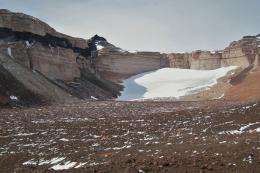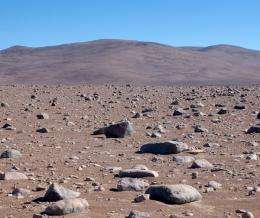A tale of two deserts

Because the surface of Mars today is bone-dry and frozen all year round, it’s difficult to find any place on Earth that is truly Mars-like. But two locations, Antarctica’s Upper Dry Valleys and the hyper-arid core of Chile's Atacama Desert, come close. They have become magnets for scientists who want to understand the limits of life on Earth and the prospects for life on Mars.
Jocelyne DiRuggiero, an associate professor of biology at Johns Hopkins University in Baltimore, Maryland, studies samples from both locations. She’s interested in the similarities and the differences between the microbial communities that live in these two extreme desert regions. In both places, very little liquid water is present. In the core of the Atacama, years can go by between one rainfall and the next, but it is warm, so when there is precipitation, a significant amount of liquid water is available for a very short time. In University Valley, one of Antarctica’s Upper Dry Valleys, the availability of liquid water is limited in a different way. University Valley receives more regular precipitation than the Atacama, but it’s so cold there that any precipitation falls in the form of snow and remains frozen.
“What we do in those environments is try to understand who is there, what those organisms might be doing, how they are distributed,” and whether the organisms are “really active metabolically,” or if instead they’re “just sitting there, because they’ve been brought by the wind.”
DiRuggiero’s primary tool is DNA sequencing. Working with soil samples that weigh one- to two-tenths of a gram each (about a teaspoonful), she extracts the DNA from any microbes present in each sample. She then sends the DNA off to a lab for sequencing.
Sample preparation is a difficult process because there aren’t many microbes in her samples. Each gram of soil contains perhaps one hundred to one thousand, an extremely low number. The same size sample of ordinary soil typically contains ten million to a billion organisms.
Because the microbial populations she’s working with are so small, contamination is a serious problem. She has to be careful not to let skin cells or hair fall into her samples. Sneezing or coughing on them could pollute them. So DiRuggiero does her work under a special hood that prevents contact with outside air. And even then she has problems, because some of the silica filters she uses to extract DNA from her samples arrive from the manufacturer with microbial cells clinging to them.
Although she has had more time to work with samples from the Atacama, DiRuggiero says the University Valley samples are particularly interesting. Because University Valley is both near the South Pole and more than a mile above sea level, the ground there stays frozen even in summer. There are few places in the world where this is true. “It’s about 40 degrees Celsius colder than the Atacama soil,” she says. That’s about 70 degrees Fahrenheit colder.
That temperature difference results in a significant difference in habitability. There are more microbes in University Valley soil than in Atacama soil.

“Right now the only parameter … we have measured that differentiates the populations, Antarctica and the Atacama, is the temperature,” DiRuggiero says. In both locations, “the soils are very dry, the soils are very low in organics, they contain a fair amount of salt. The big difference is the temperature.”
“We don’t really know what it means yet.”
It may seem odd that microbes are happier in sub-freezing conditions than in a warm desert. “This is counter to human experience but makes sense for microbes,” Chris McKay, a planetary scientist at NASA Ames Research Center in Moffett Field, California, wrote in an email. “Cold allows them to sleep, which is a good survival mechanism,” he explained, adding that “this result bodes well for life in the cold deserts of Mars.” McKay heads the NASA-funded IceBite team, which is testing a prototype coring drill for possible use on a future Mars mission. The IceBite team obtained the University Valley samples that DiRuggiero studies.
So far DiRuggiero has been working with University Valley samples collected during the IceBite team’s first season in the field, in 2009. She’s looking forward to getting her hands on more-extensive samples collected at the end of 2010, samples that are still making their way back from Antarctica.
Beneath the dry soil layer in University Valley is “what we call ice-cemented ground, which is basically frozen mud. And that mud has been frozen for thousands and thousands of years,” says DiRuggiero. “So the question is, Is there any water available for the micro-organisms, and do we see a difference in the microbial community between the soil above and this ice-cemented ground right underneath?”
There is some evidence, based on climate data collected last year by the IceBite team, that at the interface between the dry soil and the frozen mud, “there might be some melting in the summer,” says DiRuggiero. “There might be water available at least part of the time” and microbes might be “actively growing and metabolizing at least during a small portion of the year.”
“Melting,” in this case, doesn’t mean the soil gets soggy or muddy, or that the temperature gets above freezing. Rather, it means that thin layers of liquid water can form between the sand grains that make up the soil and the ice below it. But that’s plenty of water for microbes. They’re small. They don’t need a lot of water.
“At temperatures above -20ºC (-4ºF) there is a layer of unfrozen water between the sand grains and the ice. These layers can support microbial life at least [down] to -15ºC (5ºF),” McKay explained.
“On Mars today the temperatures of the ground ice are much too cold for this effect to be useful,” he wrote. But Mars wobbles. At present Mars is tilted on its axis at about the same angle as Earth’s. Five million years ago, however, Mars leaned over at an angle of about 45º, and for nearly half of each martian year (equivalent to about one Earth year), the polar regions received constant sunlight. Back then “the ground ice at the polar regions,” like the site where NASA’s Phoenix spacecraft landed in 2008, “would have been much warmer. We think it would have been in the range of -15ºC to -20ºC. So liquid water layers” in the past were “a possibility.”
The question then is this: If life ever took hold on Mars, back when the planet was warmer and wetter, did a few hardy microbes evolve a survival strategy that let them go into a deep sleep, and then every 10 or 20 million years, when the ground warmed up to -20ºC or so, wake up and put on a little growth spurt?
The answer will have to wait until a follow-up mission to the martian polar regions can dig deeper than Phoenix did. It is just such deep polar drilling that McKay’s IceBite project is working to make possible.
In the meantime, DiRuggiero will have no problem staying busy. There is still much left to learn about the dry limit of life, in both Antarctica and the Atacama.
Source: Astrobio.net




















